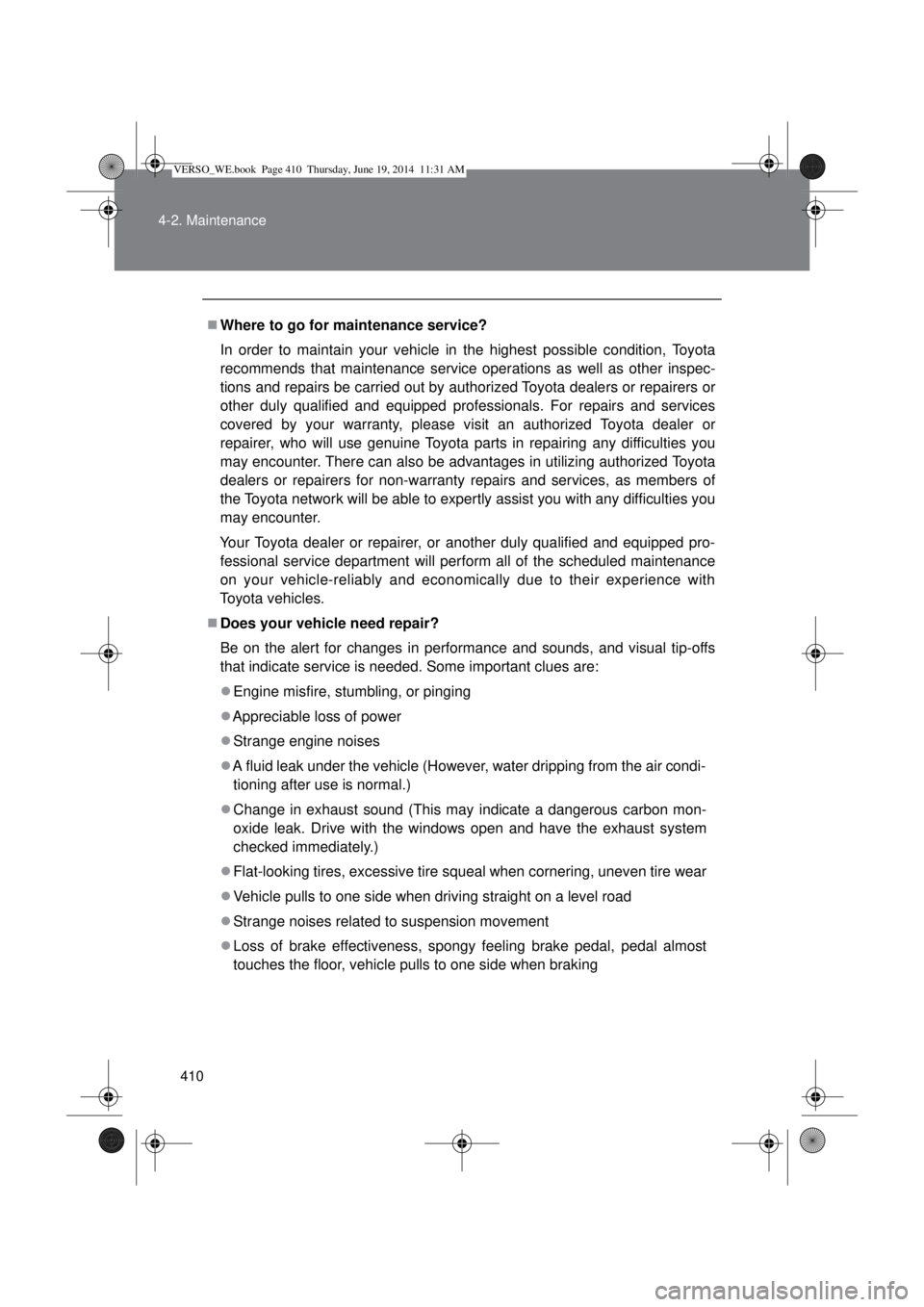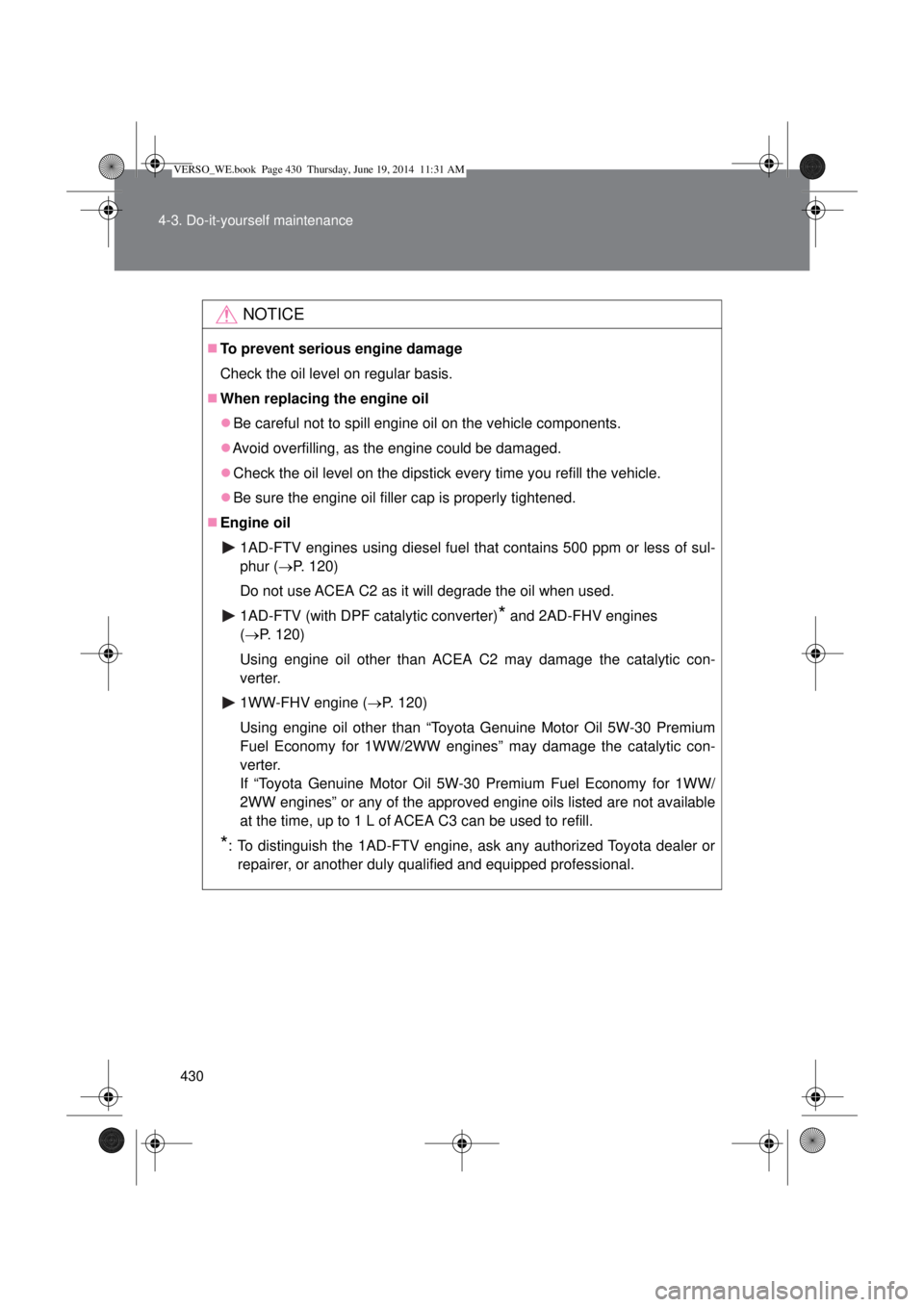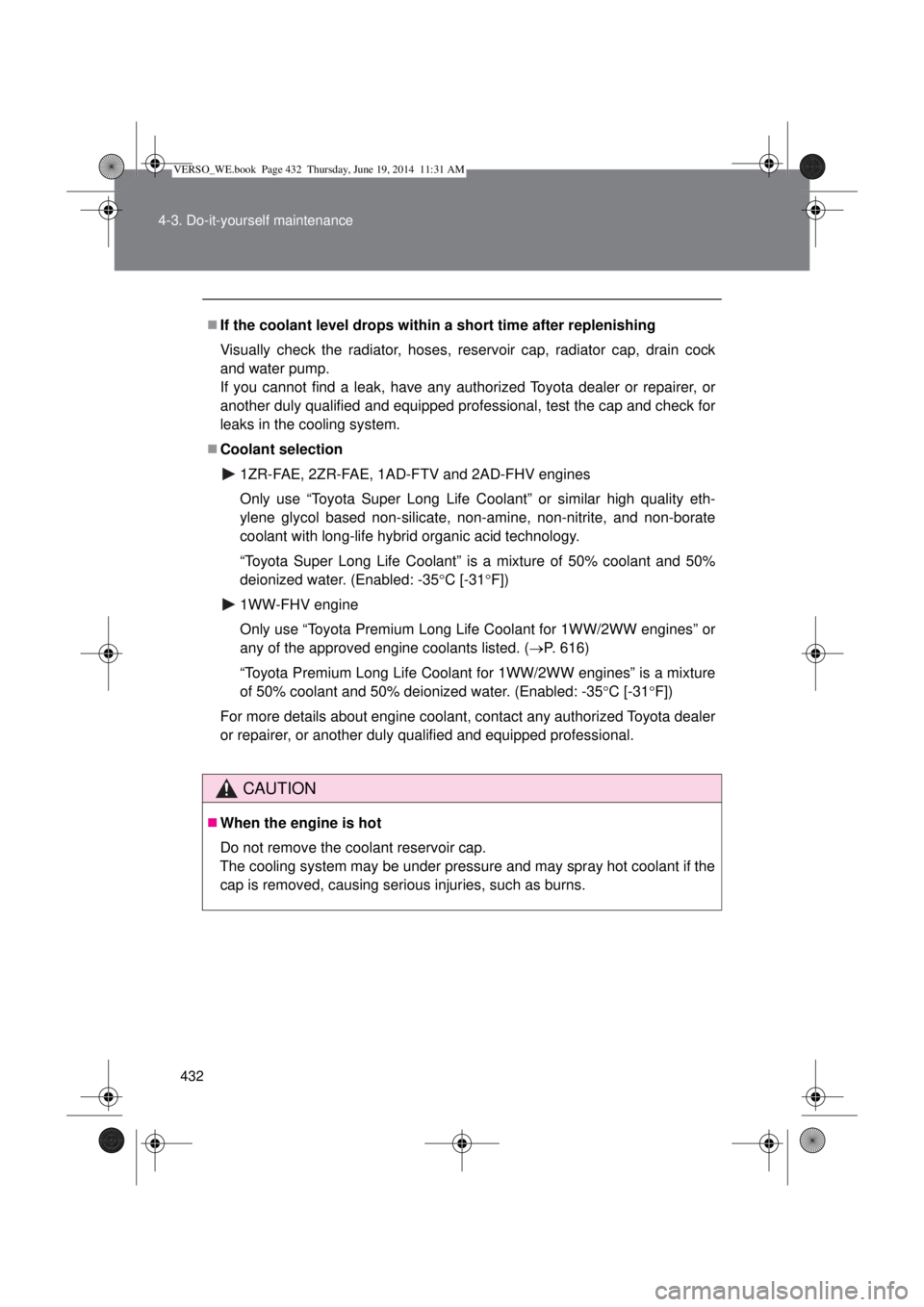Page 401 of 650
4Maintenance and care
401
4-1. Maintenance and care
Cleaning and protecting
the vehicle exterior ......... 402
Cleaning and protecting
the vehicle interior .......... 406
4-2. Maintenance
Maintenance
requirements................... 409
4-3. Do-it-yourself maintenance
Do-it-yourself service
precautions ..................... 412
Hood ................................. 416
Positioning a floor jack ...... 418
Engine compartment......... 420
Tires .................................. 443
Tire inflation pressure ....... 457
Wheels .............................. 459
Air conditioning filter ......... 462
Key battery........................ 465
Checking and replacing
fuses ............................... 469
Light bulbs ........................ 484
VERSO_WE.book Page 401 Thursday, June 19, 2014 11:31 AM
Page 410 of 650

410 4-2. Maintenance
Where to go for maintenance service?
In order to maintain your vehicle in the highest possible condition, Toyota
recommends that maintenance service operations as well as other inspec-
tions and repairs be carried out by authorized Toyota dealers or repairers or
other duly qualified and equipped professionals. For repairs and services
covered by your warranty, please visit an authorized Toyota dealer or
repairer, who will use genuine Toyota parts in repairing any difficulties you
may encounter. There can also be advantages in utilizing authorized Toyota
dealers or repairers for non-warranty repairs and services, as members of
the Toyota network will be able to expertly assist you with any difficulties you
may encounter.
Your Toyota dealer or repairer, or another duly qualified and equipped pro-
fessional service department will perform all of the scheduled maintenance
on your vehicle-reliably and economically due to their experience with
Toyota vehicles.
Does your vehicle need repair?
Be on the alert for changes in performance and sounds, and visual tip-offs
that indicate service is needed. Some important clues are:
Engine misfire, stumbling, or pinging
Appreciable loss of power
Strange engine noises
A fluid leak under the vehicle (However, water dripping from the air condi-
tioning after use is normal.)
Change in exhaust sound (This may indicate a dangerous carbon mon-
oxide leak. Drive with the windows open and have the exhaust system
checked immediately.)
Flat-looking tires, excessive tire squeal when cornering, uneven tire wear
Vehicle pulls to one side when driving straight on a level road
Strange noises related to suspension movement
Loss of brake effectiveness, spongy feeling brake pedal, pedal almost
touches the floor, vehicle pulls to one side when braking
VERSO_WE.book Page 410 Thursday, June 19, 2014 11:31 AM
Page 417 of 650
417 4-3. Do-it-yourself maintenance
4
Maintenance and care
CAUTION
Pre-driving check
Check that the hood is fully closed and locked.
If the hood is not locked properly, it may open while the vehicle is in motion
and cause an accident, which may result in death or serious injury.
When moving the support rod
High temperatures in the engine compartment cause the support rod to
become extremely hot.
When moving the supporting rod, be sure to hold the support rod cover to
prevent burns.
After installing the support rod into the slot
Make sure the rod supports the hood securely, so that it will not fall down
onto your head or body.
NOTICE
When closing the hood
Be sure to return the support rod to its clip before closing the hood. Closing
the hood with the support rod up could cause the hood to bend.
VERSO_WE.book Page 417 Thursday, June 19, 2014 11:31 AM
Page 424 of 650
424 4-3. Do-it-yourself maintenance
Engine oil
With the engine at operating temperature and turned off, check the oil
level on the dipstick.
Checking the engine oil
Park the vehicle on level ground. After warming up the engine
and turning it off, wait more than 5 minutes for the oil to drain
back into the bottom of the engine.
Hold a rag under the end and pull the dipstick out.
Gasoline engine (1ZR-FAE and 2ZR-FAE engines)
Diesel engine (1AD-FTV and 2AD-FHV engines)
VERSO_WE.book Page 424 Thursday, June 19, 2014 11:31 AM
Page 425 of 650
425 4-3. Do-it-yourself maintenance
4
Maintenance and care
Diesel engine (1WW-FHV engine)
Wipe the dipstick clean.
Gasoline engine with flat dipstick and diesel engine: Reinsert
the dipstick fully.
Gasoline engine with non-flat
dipstick: Reinsert the non-flat
dipstick fully with its protruding
areas ( in the illustration)
pointing towards the engine.
Holding a rag under the end, pull the dipstick out and check
the oil level.
Flat dipstick
Low
Normal
Excessive
The shape of the dipstick may
differ depending on the type of
vehicle or engine.
VERSO_WE.book Page 425 Thursday, June 19, 2014 11:31 AM
Page 427 of 650
427 4-3. Do-it-yourself maintenance
4
Maintenance and care
Adding engine oil
If the oil level is below or near
the low level mark, add engine
oil of the same type as already in
the engine.
Make sure to check the oil type and prepare the items needed before
adding oil.
*: To distinguish the 1AD-FTV engine, ask any Toyota dealer or repairer, or
another duly qualified and equipped professional.
Remove the oil filler cap by turning it counterclockwise.
Add engine oil slowly, checking the dipstick.
Install the oil filler cap by turning it clockwise.
Engine oil selectionP. 606
Oil quantity
(Low Full)1ZR-FAE and 2ZR-FAE engines
1.5 L (1.6 qt., 1.3 Imp.qt.)
1AD-FTV (without DPF catalytic converter)
*
engine
1.7 L (1.8 qt., 1.5 Imp.qt.)
1AD-FTV (with DPF catalytic converter)
* and
2AD-FHV engines
1.6 L (1.7 qt., 1.4 Imp.qt.)
1WW-FHV engine
1.3 L (1.4 qt., 1.1 Imp.qt.)
Items Clean funnel
VERSO_WE.book Page 427 Thursday, June 19, 2014 11:31 AM
Page 430 of 650

430 4-3. Do-it-yourself maintenance
NOTICE
To prevent serious engine damage
Check the oil level on regular basis.
When replacing the engine oil
Be careful not to spill engine oil on the vehicle components.
Avoid overfilling, as the engine could be damaged.
Check the oil level on the dipstick every time you refill the vehicle.
Be sure the engine oil filler cap is properly tightened.
Engine oil
1AD-FTV engines using diesel fuel that contains 500 ppm or less of sul-
phur (P. 120)
Do not use ACEA C2 as it will degrade the oil when used.
1AD-FTV (with DPF catalytic converter)
* and 2AD-FHV engines
(P. 120)
Using engine oil other than ACEA C2 may damage the catalytic con-
verter.
1WW-FHV engine (P. 120)
Using engine oil other than “Toyota Genuine Motor Oil 5W-30 Premium
Fuel Economy for 1WW/2WW engines” may damage the catalytic con-
verter.
If “Toyota Genuine Motor Oil 5W-30 Premium Fuel Economy for 1WW/
2WW engines” or any of the approved engine oils listed are not available
at the time, up to 1 L of ACEA C3 can be used to refill.
*: To distinguish the 1AD-FTV engine, ask any authorized Toyota dealer or
repairer, or another duly qualified and equipped professional.
VERSO_WE.book Page 430 Thursday, June 19, 2014 11:31 AM
Page 432 of 650

432 4-3. Do-it-yourself maintenance
If the coolant level drops within a short time after replenishing
Visually check the radiator, hoses, reservoir cap, radiator cap, drain cock
and water pump.
If you cannot find a leak, have any authorized Toyota dealer or repairer, or
another duly qualified and equipped professional, test the cap and check for
leaks in the cooling system.
Coolant selection
1ZR-FAE, 2ZR-FAE, 1AD-FTV and 2AD-FHV engines
Only use “Toyota Super Long Life Coolant” or similar high quality eth-
ylene glycol based non-silicate, non-amine, non-nitrite, and non-borate
coolant with long-life hybrid organic acid technology.
“Toyota Super Long Life Coolant” is a mixture of 50% coolant and 50%
deionized water. (Enabled: -35C [-31F])
1WW-FHV engine
Only use “Toyota Premium Long Life Coolant for 1WW/2WW engines” or
any of the approved engine coolants listed. (P. 616)
“Toyota Premium Long Life Coolant for 1WW/2WW engines” is a mixture
of 50% coolant and 50% deionized water. (Enabled: -35C [-31F])
For more details about engine coolant, contact any authorized Toyota dealer
or repairer, or another duly qualified and equipped professional.
CAUTION
When the engine is hot
Do not remove the coolant reservoir cap.
The cooling system may be under pressure and may spray hot coolant if the
cap is removed, causing serious injuries, such as burns.
VERSO_WE.book Page 432 Thursday, June 19, 2014 11:31 AM